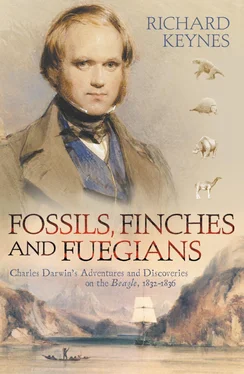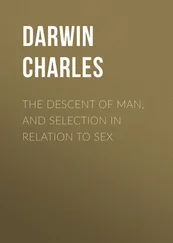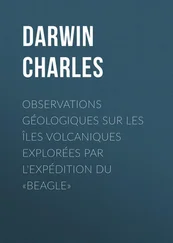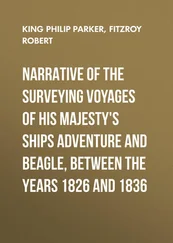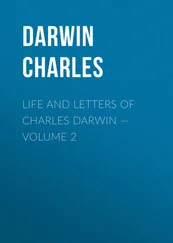This was a great disappointment to Mr Darwin, who had cherished a hope of visiting the Peak. To see it – to anchor and be on the point of landing, yet be obliged to turn away without the slightest prospect of beholding Teneriffe again – was indeed to him a real calamity. 49
The first of Charles’s zoology notes was made off Santa Cruz that day, when he wrote:
The sea was luminous in specks & in the wake of the vessel of an uniform slight milky colour. – When the water was put into a bottle it gave out sparks for some few minutes after having been drawn up. – When examined both at night & next morning, it was found full of numerous small (but many bits visible to naked eye) irregular pieces of a (gelatinous?) matter. – The sea next morning was in the same place equally impure. 50
Four days later the sea was again very luminous from the presence of myriads of tiny shrimps giving out a strong green light. Charles wrote in his journal:
I proved today the utility of a contrivance which will afford me many hours of amusement & work. It is a bag four feet deep made of bunting; & attached to a semicircular bow this by lines is kept upright, & dragged behind the vessel. This evening it brought up a mass of small animals, & tomorrow I look forward to a greater harvest. 51
This was only the second recorded use, following that of the Irish zoologist J. Vaughan Thompson a few years earlier, of a net specifically designed for the capture of plankton, the name adopted sixty years later for the many kinds of small plants (phytoplankton) or animals (zooplankton) found floating or drifting at various depths in the ocean. Unlike John Coldstream’s oyster trawl, whose lower bar was dragged along the bottom of the sea so that it gathered up the organisms that lived there, Charles’s net was intended to collect from the surface of the water. His notes continue:
11 th. I am quite tired having worked all day at the produce of my net. The number of animals that the net collects is very great & fully explains the manner so many animals of a large size live so far from land. Many of these creatures so low in the scale of nature are most exquisite in their forms & rich colours. It creates a feeling of wonder that so much beauty should be apparently created for such little purpose.
This was indeed a most auspicious beginning, for Charles was far ahead of his time in his instant perception of the significance of plankton in what nowadays would be called the oceanic food web.
During the next few days a number of interesting animals were captured in the net. One of the first was a Portuguese man-of-war, Physalia , a colonial hydrozoan of the order known as siphonophores, * which have a large horizontal float to hold them at the surface of the sea and long tentacles for capturing their prey. This particular species is well known to swimmers in the warm parts of the North Atlantic for its capability of inflicting a painful sting, as Charles quickly found when he got some of the slime on to his fingers, and on accidentally putting them into his mouth felt the disagreeable sensation, familiar to him, that biting the root of the arum lily produces. There were other hydrozoans such as sea butterflies like the By-the-Wind Sailor Velella , with a small sail on its upper surface, some salps growing in long chains, and ‘a very simple animal’ of which Charles produced an excellent picture on the first page of the twenty plates that he drew under his Bancks microscope to illustrate his Zoology Notes. He later found more of these creatures off the coasts of Brazil and Patagonia, where he described their anatomy in greater detail, but he had still not succeeded in classifying them when the Beagle returned to England in 1836. Today they are instantly recognisable as arrow-worms of the genus Sagitta , powerful carnivorous predators on other planktonic animals, which are seized by grasping spines located on either side of the head. They are plankton common in all tropical seas, but they had only been formally named in 1827, in a paper that was not in the Beagle ’s library.
On the Beagle ’s arrival at St Jago (São Tiago on a modern map) in the Cape Verde Islands on 16 January, Charles divided his time between geology in the mornings, collecting the animals that he found on the seashore in the middle of the day, and examining his specimens and writing his notes in the evening. With FitzRoy and the First Lieutenant John Wickham he visited St Jago’s famous baobab tree of legendary age, whose height was measured with naval accuracy both by triangulation and by being climbed by the Captain and letting down a string from the top. The marine wildlife included a variety of sea slugs ( Doris ), sea hares ( Aplysia ), sea urchins, sea anemones, shells, turbellarian flatworms, and some corals, but the highlight was Charles’s encounter with an octopus, of which he wrote:
Found amongst the rocks West of Quail Island at low water an Octopus. When first discovered he was in a hole & it was difficult to perceive what it was. As soon as I drove him from his den he shot with great rapidity across the pool of water, leaving in his train a large quantity of the ink. Even then, when in shallow place it was difficult to catch him, for he twisted his body with great ease between the stones & by his suckers stuck very fast to them. When in the water the animal was of a brownish purple, but immediately when on the beach the colour changed to a yellowish green. When I had the animal in a basin of salt water on board this fact was explained by its having the Chamælion like power of changing the colour of its body. The general colour of animal was French grey with numerous spots of bright yellow. The former of these colours varied in intensity, the other entirely disappeared & then again returned. Over the whole body there were continually passing clouds, varying in colour from a “hyacinth red” to a “Chesnut brown”. As seen under a lens these clouds consisted of minute points apparently injected with a coloured fluid. The whole animal presented a most extraordinary mottled appearance, & much surprised every body who saw it. The edges of the sheath were orange, this likewise varied its tint. The animal seemed susceptible to small shocks of galvanism: contracting itself & the parts between the point of contact of wires, became almost black. This in a lesser degree followed from scratching the animal with a needle. The cups were in double rows on the arms & coloured reddish. The eye could be entirely closed by a circular eyelid, the pupil was of a dark blue. The animal was slightly phosphorescent at night. 52
Charles was greatly excited by what he thought was a new discovery, and described it enthusiastically in his first letter to Henslow. But Henslow replied that he too had seen the colour changes of an octopus he had caught at Weymouth, and that the phenomenon had also been reported by others. Cuvier had indeed mentioned the ability of an octopus to outdo a chameleon in this respect, but Charles was nevertheless the first to give an accurate description of the properties of its chromatophores, the pigment cells in the skin whose rapid contraction and expansion under nervous control are responsible for the vivid colour changes in octopus and other cephalopods such as cuttlefish and squid. Their function is not only to camouflage the animals when they move to new surroundings, but as has only been appreciated very recently, to provide a means of communication between them.
In his Autobiography , Charles wrote:
The investigation of the geology of all the places visited was far more important than natural history, as reasoning here comes into play. On first examining a new district nothing can appear more hopeless than the chaos of rocks; but by recording the stratification and nature of the rocks and fossils at many points, always reasoning and predicting what will be found elsewhere, light soon begins to dawn on the district, and the structure of the whole becomes more or less intelligible. I had brought with me the first volume of Lyell’s Principles of Geology , which I studied attentively; and this book was of the highest service to me in many ways. The very first place which I examined, namely St. Jago in the Cape Verde Islands, showed me clearly the wonderful superiority of Lyell’s manner of treating geology, compared with that of any other author whose works I had with me or ever afterwards read.
Читать дальше
